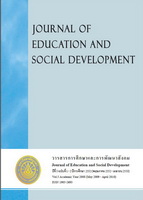การจัดการทรัพยากรทางวัฒนธรรม:การอนุรักษ์จิตรกรรมฝาผนัง ในภาคตะวันออก
Main Article Content
Abstract
บทคัดย่อ
การวิจัยนี้มีวัตถุประสงค์เพื่อ 1) ศึกษาระดับการเห็นคุณค่าของจิตรกรรมฝาผนังและระดับการมีส่วนร่วมของประชาชนในการอนุรักษ์จิตรกรรมฝาผนังในภาคตะวันออก 2) ศึกษาการมีส่วนร่วมขององค์กรเครือข่ายชุมชนที่มีการเห็นคุณค่าและมีส่วนร่วมในการจัดการทรัพยากรทางวัฒนธรรม:การอนุรักษ์จิตรกรรมฝาผนังในภาคตะวันออก และ 3) สังเคราะห์แนวทางการจัดการทรัพยากรทางวัฒนธรรมขององค์กรเครือข่ายชุมชนในการอนุรักษ์จิตรกรรมฝาผนังในภาคตะวันออก กลุ่มตัวอย่าง เป็นผู้ที่อาศัยอยู่ในแหล่งที่มีจิตรกรรมฝาผนังจำนวน 400 คน เครื่องมือที่ใช้ในการวิจัยเชิงปริมาณเป็นแบบสอบถามแบบมาตราส่วนประมาณค่า 5 ระดับ วิเคราะห์ข้อมูลโดยใช้ค่าเฉลี่ย ส่วนเบี่ยงเบนมาตรฐาน การวิเคราะห์จำแนกกลุ่ม (Discriminant Analysis) การวิจัยเชิงคุณภาพใช้วิธีการสัมภาษณ์บุคคลในองค์กรเครือข่ายในการอนุรักษ์จิตรกรรมฝาผนังในภาคตะวันออก จำนวน 44 คน และวิเคราะห์ข้อมูลโดยวิเคราะห์เนื้อหา (Content Analysis)
ผลการวิจัยพบว่า
1. ระดับการเห็นคุณค่าของจิตรกรรมฝาผนังของประชาชนในจังหวัดภาคตะวันออกอยู่ในระดับปานกลาง ระดับการมีส่วนร่วมในการอนุรักษ์จิตรกรรมฝาผนังอยู่ในระดับน้อยในมิติคุณค่าที่แสดงนัยของอดีตและ การตัดสินใจของประชาชนที่อยู่บริเวณใกล้เคียงแหล่งจิตรกรรมฝาผนังกลุ่มที่เห็นคุณค่า และกลุ่มที่ไม่เห็นคุณค่าของจิตรกรรมฝาผนัง มีความแตกต่างกันอย่างมีนัยสำคัญทางสถิติที่ระดับ .05 ส่วนคุณค่าทางวิชาการ คุณค่าความงาม คุณค่าทางเศรษฐศาสตร์และการมีส่วนร่วมในการดำเนินงาน การมีส่วนร่วมในผลประโยชน์ การมีส่วนร่วมในการประเมินผลไม่มีควาแตกต่างกันอย่างมีนัยสำคัญทางสถิติ
2. การมีส่วนร่วมขององค์กรเครือข่ายชุมชนในการจัดการทรัพยากรทางวัฒนธรรม : การอนุรักษ์จิตรกรรมฝาผนังในภาคตะวันออก 1) การวางแผนชุมชนท้องถิ่นส่วนใหญ่ยังขาดข้อมูลและความรู้เกี่ยวกับจิตรกรรมฝาผนัง ส่วนใหญ่จะปล่อยให้เสื่อมโทรมไปตามสภาพ เห็นจิตรกรรมฝาผนังเป็นสัญลักษณ์ของอดีต แต่มิได้นำมาใช้ประโยชน์ในปัจจุบัน ให้คุณค่าในฐานะที่เป็นตัวแทนของประวัติศาสตร์ 2) การจัดองค์การ: เจ้าอาวาสวัดกรรมการวัดจะได้รับความไว้วางใจให้ตัดสินใจเกี่ยวกับการจัดการทรัพยากรทางวัฒนธรรม การอนุรักษ์จิตรกรรมฝาผนังส่วนใหญ่มักจะคงสภาพเดิมไว้ เนื่องจากองค์กรในระดับท้องถิ่น ยังขาดความพร้อมของบุคลากรในการดำเนินงานด้านวัฒนธรรม 3) การควบคุม : สนับสนุนให้มีการรวมกลุ่ม และสร้างเครือข่ายความร่วมมือในการพัฒนาประสิทธิภาพของกลุ่มและผู้นำกลุ่มชุมชนที่มีความเข้มแข็งในการจัดการทรัพยากรทางวัฒนธรรม
3. แนวทางการจัดการและอนุรักษ์จิตรกรรมฝาผนังในภาคตะวันออก 1) ส่งเสริมให้ชุมชนมีความพร้อมในการจัดการทรัพยากรทางวัฒนธรรม โดยการจัดสรรงบประมาณและสนับสนุนการรวมกลุ่มของประชาชนในการอนุรักษ์ศิลปกรรมในชุมชน พร้อมทั้งให้ความรู้ในด้านการจัดการทรัพยากรทางวัฒนธรรม 2) ส่งเสริมและสนับสนุนให้ประชาชนและชุมชนรับผิดชอบการดำเนินงานวัฒนธรรมของชุมชนเอง โดยฝึกอบรมเพื่อให้สามารถดำเนินการอนุรักษ์จิตรกรรมฝาผนังเท่าที่สามารถทำได้ 3) สนับสนุนให้มีการศึกษาวิจัยองค์ความรู้จิตรกรรมฝาผนังในภาคตะวันออก เพื่อเป็นฐานความรู้และเผยแพร่สู่ชุมชน
ABSTRACT
The purposes of the research were to 1) study the level of appreciation of murals painting and participation in mural painting conservation of people in the eastern region; 2) study the participation in cultural management with regard to the conservation of murals painting; 3) to seek appropriate approaches to manage the cultural resources of community network organizations in order to conserve murals painting in the eastern region. A five-level rating scale questionnaire was used with 400 people living near mural painting sites. Mean, S.D. and Discriminant Analysis were used to analyze the data. 44 representatives from the mural painting conservation network in the eastern region were interviewed by the researcher. Content Analysis was used to analyze the data. The research results were as follows:
1. The appreciation of murals painting of people in the eastern region was at a moderate level. The participation in mural painting conservation of the participants was at a low level. Associative value and appreciation of historical artwork decisions of participants who appreciated and those who did not appreciate murals painting were different at the.05 level of significance. Informational value, aesthetic value and economic value, and participation in implementation, participation in benefits and participation in evaluation are not significantly different.
2. In terms of participation in cultural management of community network organizations, it was found that 1) Planning: most local communities lacked information and knowledge about murals painting. The people in the communities let murals deteriorate. They perceived murals painting as the symbols of the past and history which has no use to them. 2) Organization management: abbots and temple representatives were trusted in cultural management decision making. Since there were not enough qualified cultural management officers, mural restoration was merely to maintain the conditions of the murals painting. 3) Controlling : The communities promoted group-building and network cooperation to develop the effectiveness of the groups and group leaders who had strong leadership in cultural resource management.
3. Regarding mural painting management and mural painting conservation in the eastern region, it was found that appropriate methods to help conserve murals painting in the eastern region were 1) Promoting local communities to be able to manage their cultural resources by providing budget and promoting group-building to conserve art work in the communities as well as educate people in cultural resource management. 2) Encouraging people in the communities to take responsibility in their cultural management. 3) Promoting mural painting study and study of Body of Knowledge of murals in the eastern region in order to be resources in providing knowledge of murals painting to communities

